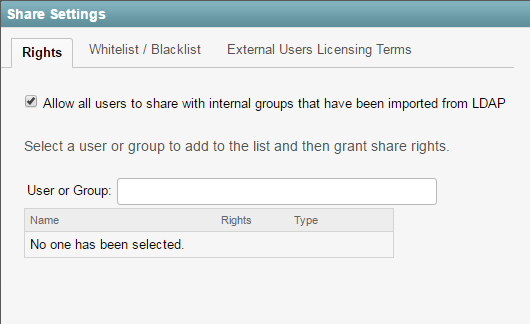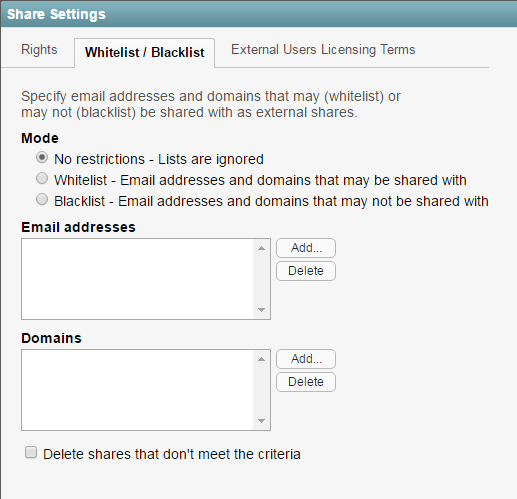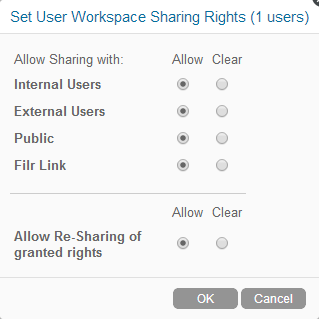7.2 Enabling Users to Share
IMPORTANT:You must enable the sharing feature before any sharing can take place on the Vibe system.
After you enable the sharing feature, the default behavior for whether users can share files from their personal workspace differs depending on whether the user is new to the Vibe system after Vibe 4, or if the user existed in the Vibe system prior to Vibe 4:
-
New users: Users who are new to the Vibe system after Vibe 4 are able to share items from their personal workspace by default.
-
Existing users: Users who existed in the Vibe system prior to Vibe 4 do not automatically have rights to share items from their personal workspace.
For users to be able to share files that are located outside of their personal workspace (such as their team workspaces, etc.), sharing must be enabled on the individual workspace. For information about how to enable sharing for the top-level Global and Team workspaces, see Enabling Sharing on Workspaces.
When you enable users to share, it is best to keep the share rights fairly unrestricted (for example, give the All Internal Users group the ability to share whatever they want). You can then restrict sharing of files in the personal workspace on a per-user basis.
When you set up sharing for your Vibe site, complete the necessary steps in the following order:
-
Set up sharing for the entire Vibe site (as described in Enabling Sharing for All Users).
-
Configure sharing for individual users (as described in Modifying Share Rights on a User Basis).
After you have enabled sharing for the entire Vibe system, you can fine-tune share rights throughout the site on the user level.
You might need to do this for the following reasons:
-
If you want only certain users to be allowed to share files from their personal workspace. After you have enabled sharing for the entire site (as described in Enabling Sharing for All Users), then you can restrict sharing privileges at the user level.
For example, if you want only a few groups of users to be allowed to share with external users, you first need to enable sharing to external users at the site level. After you have enabled it at the site level, you can then remove this ability from the users who you do not want to have this ability.
-
If there are users who existed in your Vibe system prior to Vibe 4, and you want these users to be able to share items from their personal workspace, you must modify the workspace share rights for these users at the user level.
-
7.2.1 Enabling Sharing for All Users
-
Log in to the Vibe site as the Vibe administrator.
-
Launch a web browser.
-
Specify one of the following URLs, depending on whether you are using a secure SSL connection:
http://Vibe_hostname:8080 https://Vibe_hostname:8443
Replace Vibe_hostname with the hostname or fully qualified domain name of the Vibe server that you have set up in DNS. If you configured the HTTP ports correctly during installation, you do not need to include the port number in the Vibe URL.
Depending on how you have configured your Vibe system, you might not be required to enter the port number in the URL. If you are using NetIQ Access Manager, the Vibe login screen is not used.
-
-
Click the admin link in the upper-right corner of the page, then click the Administration Console icon
 .
. -
Under System, click Share Settings.
The Share Settings page is displayed.

-
Select Allow all users to share with groups that have been imported from LDAP to enable users to share with LDAP groups.
If you select this option, groups that were imported from the LDAP directory are displayed in the Share with field when users are sharing an item (as described in
Sharing Entries, Folders, and Workspaces
in the OpenText Vibe 4.0.8 User Guide). All users in the LDAP group then have access to the item that was shared. -
To enable sharing for all internal users on the Vibe site, go to the User or Group field, begin typing All Internal Users, then select it when it appears in the drop-down list.
or
To enable sharing on a per-user or per-group basis, go to the Select user/group field, begin typing the name of the user or group for whom you want to grant share rights, then select the name when it appears in the drop-down list.
The Edit Share Rights dialog box is displayed. Select from the following options:
Re-share items: When users share a file or folder, they can give the users they are sharing with the ability to re-share the file or folder. The user receiving the share can share the file only if that user has been given administrative rights to share the file or folder.
IMPORTANT:When selecting this option, be aware that if one user's access rights to an item are removed, it does not remove the access rights of the user with whom the item was re-shared.
For example, suppose User A shares an item with User B and grants re-share rights. User B then shares the item with User C. If User A revokes User B's access rights to the item, User C continues to have access to the shared item.
Share with Internal users: lets users share items with internal users.
Share with “All Internal Users” group: lets users perform a mass share to all internal users by sharing with the All Internal Users group.
Share with External users: lets users share items with users external to the organization.
Users external to the organization receive an email notification with a link to the shared item, and they can then log in to the Vibe site. For more information, see
Sharing with People Outside Your Organization
in the OpenText Vibe 4.0.8 User Guide.Share with Public: lets users make items publicly available. This means that anyone with the correct URL to the shared item can access the shared item without logging in to the Vibe site.
In addition to selecting this option, you also need to enable Guest access to the Vibe site if you want to allow users to share items with the public. For information about how to enable Guest access to the Vibe site, see Setting Up Guest Access for the Vibe Site.
Share using File Link: lets users share a link to a file in Vibe. Any user with the link can then access the file. However, the file is not displayed in the Public area, so users must have direct access to the link in order to access the file.
For more information about File Links, see
Distributing a Link to a File
in the OpenText Vibe 4.0.8 User Guide. -
(Optional) Click the Whitelist / Blacklist tab to configure which email addresses and domains users can share with when sharing externally.

The following options are available when configuring a whitelist or blacklist for sharing:
No restrictions: Select this option to disregard any email addresses or domains that might already exist in the Email addresses and Domains fields. Selecting this option means that users can share with any email address.
Whitelist: Select this option to allow sharing only with email addresses and domains that have been specified in the Email addresses and Domains fields.
Blacklist: Select this option to disallow sharing with any email addresses and domains that have been specified in the Email addresses and Domains fields.
Email addresses: Click Add, specify the email address that you want to add to the whitelist or blacklist, then click OK.
Repeat this process to add multiple email address.
Domains: Click Add, specify the domain that you want to add to the whitelist or blacklist (for example, yahoo.com), then click OK.
Repeat this process to add multiple domains.
Delete shares that don’t meet the criteria: Select this option to delete all existing shares in the Vibe system that do not match the criteria you set.
For example, if you selected Blacklist and then specified yahoo.com in the Domains field, selecting this option would delete all Vibe shares made to Yahoo email addresses.
-
Click OK.
-
Modify individual user share rights as described in Modifying Share Rights on a User Basis.
7.2.2 Modifying Share Rights on a User Basis
After you have enabled sharing of files for the entire Vibe system (as described in Enabling Sharing for All Users), you can modify share rights throughout the site on the user level.
You might need to do this for the following reasons:
-
If you want only certain users to be allowed to share files from their personal workspace. After you have enabled sharing for the entire site (as described in Enabling Sharing for All Users), then you can restrict sharing privileges at the user level.
For example, if you want only a few groups of users to be allowed to share with external users, you first need to enable sharing to external users at the site level. After you have enabled it at the site level, you can then remove this ability from the users who you do not want to have this ability.
-
If there are users who existed in your Vibe system prior to Vibe 4, and you want these users to be able to share items from their personal workspace, you must modify the workspace share rights for these users at the user level.
You cannot grant individual users more rights than are currently defined for the site-wide setting.
To modify share rights for specific users:
-
Log in to the Vibe site as the Vibe administrator.
-
Launch a web browser.
-
Specify one of the following URLs, depending on whether you are using a secure SSL connection:
http://Vibe_hostname:8080 https://Vibe_hostname:8443
Replace Vibe_hostname with the hostname or fully qualified domain name of the Vibe server that you have set up in DNS. If you configured the HTTP ports correctly during installation, you do not need to include the port number in the Vibe URL.
Depending on how you have configured your Vibe system, you might not be required to enter the port number in the URL. If you are using NetIQ Access Manager, the Vibe login screen is not used.
-
-
Click the admin link in the upper-right corner of the page, then click the Administration Console icon
 .
. -
Under Management, click Users.
-
Select the users whose sharing rights you want to manage, then click More > Workspace Share Rights.

-
Select the radio button in the Clear column next to the sharing right that you want to remove from the user or group, then click OK.
or
If you have already removed a share right and you want to add it again, select the radio button in the Allow column next to the sharing right that you want to add to the user or group, then click OK.